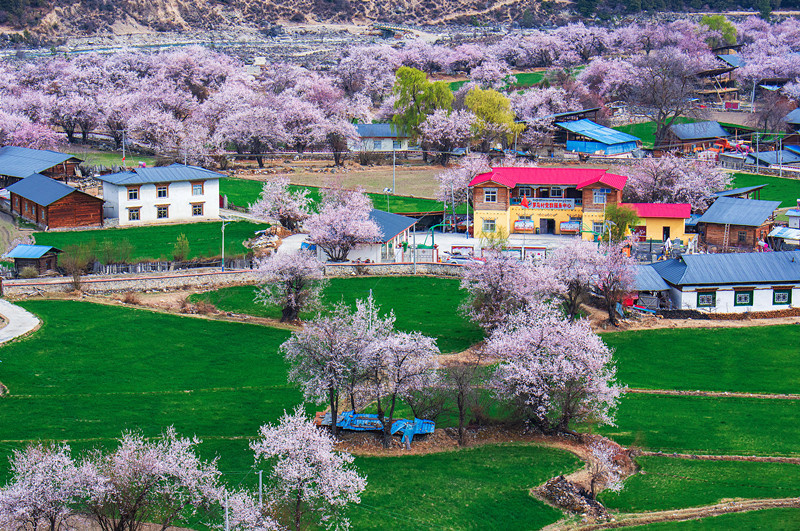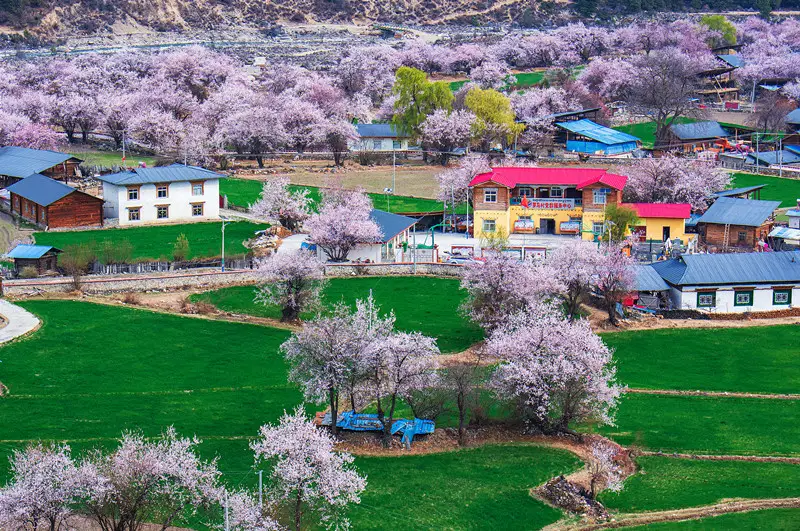By Yang Hao, People’s Daily

Photo taken on March 26 shows a beautiful view in Luoma village, Zayu county, southwest China’s Tibet autonomous region. (Photo by You Jinhua/People’s Daily Online)
The Chinese central government allocated a total investment of 1.63 trillion yuan ($253 billion) in the past 70 years since the peaceful liberation of Tibet, said Wu Yingjie, secretary of Tibet Autonomous Regional Committee of the Communist Party of China (CPC).
The southwestern autonomous region also received a total of 69.3 billion yuan of funds from other provincial and municipal governments in recent years, Wu said at a press conference on the economic and social development of Tibet on May 22.
Over 590 billion yuan of the total investment were put into the construction of major projects that have greatly driven the region’s economic development, including the Sichuan-Tibet Highway, Qinghai-Tibet Railway, Lhasa Kongga International Airport and Zangmu Dam.
Tibet was once a contiguous poor area that suffered the highest poverty headcount ratio, the deepest poverty, as well as the highest cost and difficulties in poverty reduction. Through targeted measures and assistance, the autonomous region has lifted all 628,000 of the registered poor people out of poverty and delisted 74 county-level areas from the poverty list.
The average per capita disposal income of rural residents stood at 14,598 yuan last year, up 12.7 percent year on year and maintaining double-digit growth for 18 consecutive years, Wu introduced.
Qizhala, chairman of the regional government noted that during the 13th Five-year plan period (2016-2020), the central government planned an investment of 380.7 billion yuan for Tibet, but the actual amount put into place reached 393.7 billion yuan. The massive investment has led to a giant leap forward in infrastructure construction and people's livelihood, he added.
For the next five years, he said, investment poured into Tibet will grow with a fairly large margin from the previous period, with focus on ecological development, people's wellbeing, social governance and construction of the border areas, he introduced.
Tibet takes education development as a priority. A modern education system was gradually put in place that covers preschool, basic, vocational, higher, continuing and special education. The right to receive education is fully enjoyed by all the ethnic peoples of Tibet.
Currently, Tibet has 3,195 schools of various types, where 880,000 students are receiving education, Qizhala said, adding that the gross enrollment rates of preschools and primary schools have reached 87 percent and 99.9 percent, respectively. The retention rate of nine-year compulsory education was 95 percent, he said.
Since the 18th CPC National Congress in 2012, a financial aid system that covers from preschool to higher education has been established in Tibet. China adopts a "three guarantees" policy that provides food, accommodation and school expenses for children of farmers and herdsmen. So far, over 18 billion yuan of aid has been offered to over 11 million students. Besides, the autonomous region has also rolled out 40 policies to help the students.
Since 2012, Tibet has made steady progress in medical and health services, sharing synchronous development with the rest of the country and protecting the health rights of all people in Tibet. The development of medical and health services in Tibet has been accelerated, and a healthcare service network that covers five administrative levels has been built. Medical workers from renowned hospitals across China have been selected to support Tibet, and hospitals have been paired up for assistance. At present, there are three national-level health centers, one university, and 19 enterprises of Tibetan medicine and therapies.
Practices prove that without the CPC, there would be no new China, let alone a new socialist Tibet, Wu said. Only by adhering to the leadership of the CPC, the socialism with Chinese characteristics and regional ethnic autonomy can Tibet secure a prosperous present and a brighter future, he noted.
The southwestern autonomous region also received a total of 69.3 billion yuan of funds from other provincial and municipal governments in recent years, Wu said at a press conference on the economic and social development of Tibet on May 22.
Over 590 billion yuan of the total investment were put into the construction of major projects that have greatly driven the region’s economic development, including the Sichuan-Tibet Highway, Qinghai-Tibet Railway, Lhasa Kongga International Airport and Zangmu Dam.
Tibet was once a contiguous poor area that suffered the highest poverty headcount ratio, the deepest poverty, as well as the highest cost and difficulties in poverty reduction. Through targeted measures and assistance, the autonomous region has lifted all 628,000 of the registered poor people out of poverty and delisted 74 county-level areas from the poverty list.
The average per capita disposal income of rural residents stood at 14,598 yuan last year, up 12.7 percent year on year and maintaining double-digit growth for 18 consecutive years, Wu introduced.
Qizhala, chairman of the regional government noted that during the 13th Five-year plan period (2016-2020), the central government planned an investment of 380.7 billion yuan for Tibet, but the actual amount put into place reached 393.7 billion yuan. The massive investment has led to a giant leap forward in infrastructure construction and people's livelihood, he added.
For the next five years, he said, investment poured into Tibet will grow with a fairly large margin from the previous period, with focus on ecological development, people's wellbeing, social governance and construction of the border areas, he introduced.
Tibet takes education development as a priority. A modern education system was gradually put in place that covers preschool, basic, vocational, higher, continuing and special education. The right to receive education is fully enjoyed by all the ethnic peoples of Tibet.
Currently, Tibet has 3,195 schools of various types, where 880,000 students are receiving education, Qizhala said, adding that the gross enrollment rates of preschools and primary schools have reached 87 percent and 99.9 percent, respectively. The retention rate of nine-year compulsory education was 95 percent, he said.
Since the 18th CPC National Congress in 2012, a financial aid system that covers from preschool to higher education has been established in Tibet. China adopts a "three guarantees" policy that provides food, accommodation and school expenses for children of farmers and herdsmen. So far, over 18 billion yuan of aid has been offered to over 11 million students. Besides, the autonomous region has also rolled out 40 policies to help the students.
Since 2012, Tibet has made steady progress in medical and health services, sharing synchronous development with the rest of the country and protecting the health rights of all people in Tibet. The development of medical and health services in Tibet has been accelerated, and a healthcare service network that covers five administrative levels has been built. Medical workers from renowned hospitals across China have been selected to support Tibet, and hospitals have been paired up for assistance. At present, there are three national-level health centers, one university, and 19 enterprises of Tibetan medicine and therapies.
Practices prove that without the CPC, there would be no new China, let alone a new socialist Tibet, Wu said. Only by adhering to the leadership of the CPC, the socialism with Chinese characteristics and regional ethnic autonomy can Tibet secure a prosperous present and a brighter future, he noted.
 Menu
Menu
 Tibet witnesses historic changes over past seven decades
Tibet witnesses historic changes over past seven decades
















